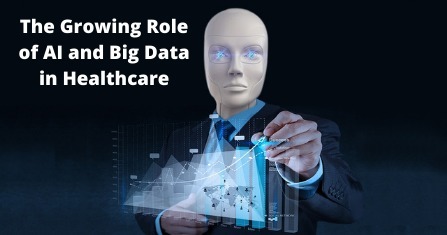One of the fastest-growing parts of the economy in the last ten years has been healthcare, and in light of the growing threats of pandemics like the coronavirus outbreak, the industry is set to rise once again. To stay ahead of the curve in demand for healthcare services and solutions, organizations worldwide are turning to advanced techniques like AI, machine learning, and Big Data.
AI is going to be huge in healthcare. According to Acumen Research and Consulting, the global market will hit $8 billion by 2026 and there is a huge overlap of skills in AI and big data—where the processing of information is optimized to help solve business and real-world problems. AI and big data provide numerous potential benefits for individuals and companies alike, including:
Empowering patient self-service with chatbots
Diagnosing patients with faster computer-aided design
Analyzing image data to examine the molecular structure in drug discovery, and by radiologists to analyze and diagnose patients
Personalizing treatments with more insightful clinical data
Let’s take a look at a few examples of AI and big data at work in the healthcare sector.
AI Combats Serious Illness with Better Predictions
AI and big data provide great value when they can boost the speed with which scientists and healthcare professionals can process and utilize data. One company that is at the forefront of change in the industry is Amgen, the world’s largest independent biotech company, as highlighted recently in Wired Magazine. By combining life sciences with big data, the company can combat dangerous illnesses such as cancer and cardiovascular disease. Various examples cited include:
Boosting the accuracy of osteoporosis risk predictions in women, thereby reducing the risk window from ten years to two
Creating machine learning algorithms and devices to predict the risk of cardiovascular disease before it strikes
Arming clinicians with AI-driven insights into patient responses to various therapies to improve overall patient satisfaction
In-Patient Mobility Monitoring
The clinical staff is busy people. Take intensive care unit (ICU) nurses, for example, who often have multiple patients in critical condition under their watch. Limited mobility and cognition during long-term treatments can adversely affect the patients’ overall recovery. Monitoring their activity is vital. To improve outcomes, researchers at Stanford University and Intermountain LDS Hospital installed depth sensors equipped with ML algorithms in patients’ rooms to keep track of their mobility. The technology accurately identified movements 87 percent of the time. Eventually, the researchers aim to provide ICU staff with notifications when patients are in trouble.
Clinical Trials for Drug Development
One of the biggest challenges in drug development is conducting successful clinical trials. As it stands now, it can take up to 15 years to bring a new – and potentially life-saving – a drug to market, according to a report published in Trends in Pharmacological Sciences. It can also cost between $1.5 and $2 billion. Around half of that time is spent in clinical trials, many of which fail. Using AI technology, however, researchers can identify the right patients to participate in the experiments. Further, they can monitor their medical responses more efficiently and accurately — saving time and money along the way.
Quality of Electronic Health Records (EHR)
Ask any healthcare professional what the bane of their existence is, and undoubtedly cumbersome EHR systems will come up. Traditionally, clinicians would manually write down or type observations and patient information, and no two did it the same. Often, they would do it after the patient visit, inviting human error. With AI- and deep learning-backed speech recognition technology, however, interactions with patients, clinical diagnoses, and potential treatments can be augmented and documented more accurately and in near real-time.
Physical Robots Use AI Too
Robots (the physical kind) are being used today in many types of businesses, such as in manufacturing and warehousing. But, robots are increasingly being used in hospitals as well, and many are designed to leverage AI. The National Center for Biotechnology Information (NCBI) reported that physical robots are becoming more collaborative with humans and can be trained to perform various tasks empowered by AI logic. And it’s not just delivering supplies in hospitals. Surgical robots can “provide ‘superpowers’ to surgeons, improving their ability to see and create precise and minimally invasive incisions, stitch wounds, and so forth.” With AI driving their decision-making processes, robots can improve the speed and quality of a wide range of medical services.
Improving Population Health
Population health studies patterns and conditions that affect the overall health of groups (unlike “public health,” which focuses on how society ensures more healthy people). Big data is a massive part of this effort. A recent article in BuiltIn highlighted various companies that are leveraging big data to help healthcare organizations and researchers read the trends to improve health conditions.
For example, one company called Linguamatics in Cambridge, MA uses natural language processing to mine through unstructured patient data to detect relevant lifestyle factors and predict which patients may be at higher risk for disease. Another company in Santa Clara, CA, called Hortonworks, helps organize and integrate billions of records so that pharmaceutical companies can do better research for clinical trials, raise the level of safety, and get products to market faster.
How Big Data Can Fight Cancer
Big data technologies are also being used in the battle against cancer. As reported in National Geographic, big data technologies can process clinical data to reveal hidden patterns that result in earlier diagnosis of cancer. The earlier it’s detected, the better the chances are for treating it. Big data technologies are adept at analyzing genome sequencing to identify biomarkers for cancer, and can also reveal groups that are at particular risk for cancer and find otherwise undiscovered treatments. The most progressive companies are using big data techniques to speed their analyses and create treatments faster and with more tangible results.



 Your new post is loading...
Your new post is loading...









